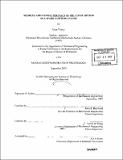Sources and characteristics of oil consumption in a spark-ignition engine
Author(s)
Yilmaz, Ertan, 1970-
DownloadFull printable version (21.76Mb)
Other Contributors
Massachusetts Institute of Technology. Dept. of Mechanical Engineering.
Advisor
John B. Heywood and Victor W. Wong.
Terms of use
Metadata
Show full item recordAbstract
(cont.) At low load, oil flowing past by the piston was found to be the major consumption source, while the contributions of oil evaporation and of blowby entrainment became more significant with increasing engine load. Furthermore, an extensive study was conducted to measure and analyze the oil consumption behavior during engine load transients to simulate real driving conditions. This work is an important step in advancing the understanding of oil consumption sources in spark ignition engines. Engine oil consumption is an important source of hydrocarbon and particulate emissions in automotive engines. In addition, chemical compounds present in oil additives poison catalytic converters and reduce their conversion efficiency. As a part of the effort to comply with increasingly stringent emission standards, engine manufacturers strive to minimize engine oil consumption. This requires the advancement of the understanding of the characteristics, sources, and driving mechanisms of oil consumption. There is a general lack of oil consumption studies that connect comprehensive experiments and theoretical analysis. In this work, a combined theoretical and experimental approach was used to separate and quantify different oil consumption sources in a production spark ignition engine at different engine operating conditions. An extensive diagnostic system was successfully implemented on the test engine to measure real time oil consumption and in-cylinder parameters that affect major consumption sources such as inter-ring pressures, oil film thickness in the piston-ring-pack, and liner temperatures. A multi-species liner evaporation model was developed and verified by testing two oils with different volatility at varying cylinder liner temperatures and engine speed and load conditions. The experimental and modeling results were used to separate and quantify the contributions of oil evaporation, oil entrained in the blowby gas flow, and oil flow into the combustion chamber passing by the piston system to total engine oil consumption. The results show that the contribution of each consumption source varies with engine operating conditions.
Description
Thesis (Ph. D.)--Massachusetts Institute of Technology, Dept. of Mechanical Engineering, 2003. Includes bibliographical references (leaves 159-163).
Date issued
2003Department
Massachusetts Institute of Technology. Department of Mechanical EngineeringPublisher
Massachusetts Institute of Technology
Keywords
Mechanical Engineering.